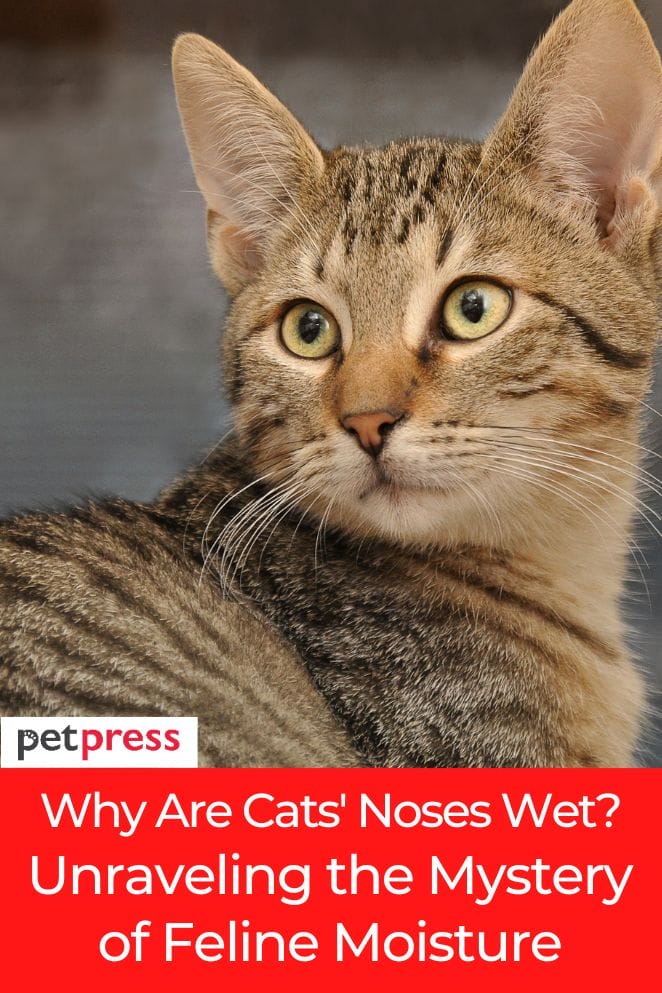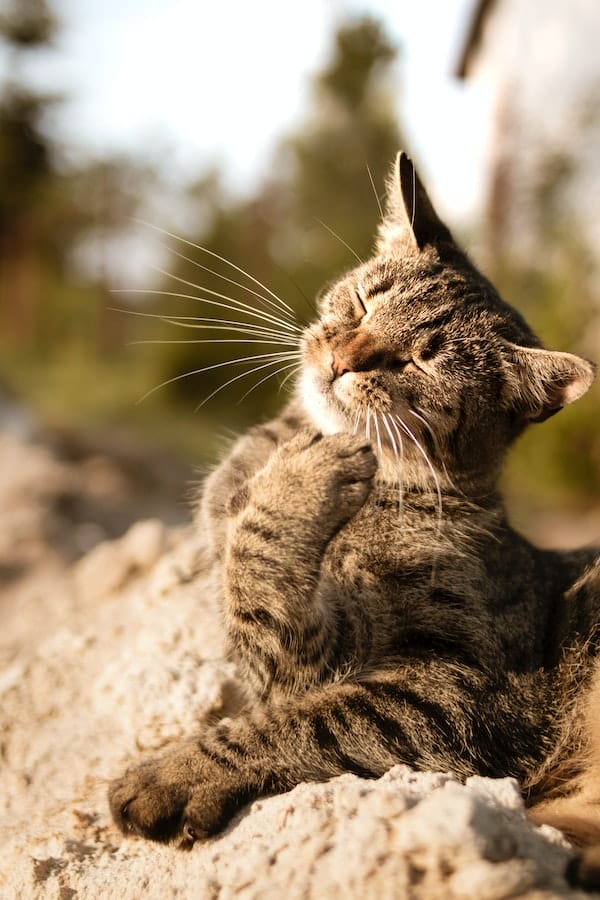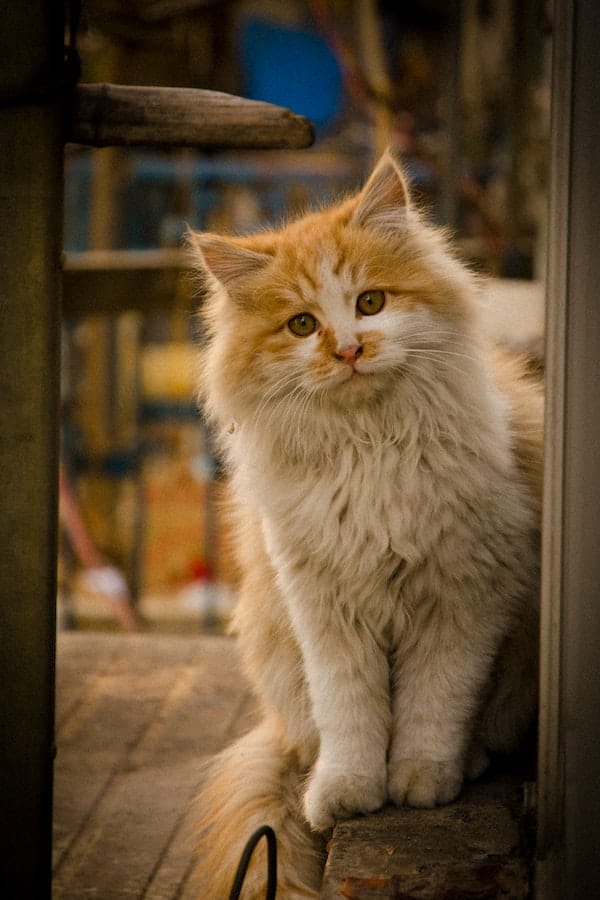
Have you ever wondered why your cat’s nose is always wet?
Cats are mysterious creatures with many intriguing behaviors, and their wet noses are no exception.
In this article, we’ll explore the fascinating world of why cats’ noses are wet, share some fun facts about these feline snouts, and provide you with a deeper understanding of your furry friend’s unique features.
Why Are Cats’ Noses Wet?
The moisture on a cat’s nose serves multiple purposes, and it’s a crucial part of their sensory toolkit. Here’s why cats’ noses are naturally damp:
Temperature regulation
Unlike humans who rely on sweat to cool down, cats lack sweat glands distributed across their bodies.
Instead, they have developed alternative mechanisms to manage their body temperature.
One of these mechanisms involves the moisture on their noses.
In hot weather, this moisture can evaporate, providing a cooling effect.
It’s almost like a natural form of air conditioning.
This clever adaptation helps cats regulate their body temperature, preventing overheating during scorching summer days.
So, when you see your feline friend with a glistening nose on a hot afternoon, know that it’s their ingenious way of staying cool.
Enhanced smell detection
Cats are renowned for their acute sense of smell, and a wet nose plays a vital role in enhancing this remarkable ability.
The moisture on their noses acts as a magnet for scent particles suspended in the air.
When a cat encounters a scent, whether it’s from a potential prey item or a new visitor in the household, the dampness on its nose helps trap and concentrate those scent molecules.
This concentration of odor facilitates a more detailed analysis of the scent, allowing cats to discern nuances that might elude us humans.
This heightened sense of smell is invaluable for both hunting and navigating their environment, making it an essential tool in their daily lives.
Communication
Cats are known for their complex social dynamics, and the moisture on their noses plays a significant role in their communication repertoire.
When cats engage in behaviors like nuzzling or touching noses with each other, they are, in fact, transferring scent markings.
These scent markings act as a form of social interaction, conveying information about their identity and emotional state.
It’s akin to a feline handshake, where they exchange vital data through the scent molecules left behind on each other’s noses.
These scent markings help establish and strengthen social bonds among cats and can even serve as a territorial marker, indicating ownership of a particular area.
Hydration
Interestingly, a cat’s nose can become wet due to another aspect of their behavior—self-grooming.
Cats are meticulous groomers and often lick their noses as part of this grooming ritual.
This act not only keeps their nose clean but also serves a practical purpose in maintaining hydration.
Cats are notorious for being somewhat finicky when it comes to drinking water, and they may not consume sufficient amounts through conventional drinking.
Licking their nose provides a means of replenishing moisture, helping them stay adequately hydrated even when their water bowl doesn’t see much action.
It’s a testament to their resourcefulness and adaptation in ensuring their well-being.

Fun Facts About Cat Noses
Fact #1: Distinctive nose patterns
Much like the human fingerprint, a cat’s nose carries its own distinctive pattern of ridges and bumps.
This unique nasal pattern is not only a testament to the individuality of each cat but also plays a role in their sensory perception.
While our fingerprints serve various purposes, such as gripping objects, a cat’s nose pattern remains a fascinating quirk of nature, adding to the mystique of these enigmatic creatures.
Fact #2: Jacobson’s organ
Cats possess a remarkable sensory organ called Jacobson’s organ, also known as the vomeronasal organ.
This unique structure is located on the roof of their mouth, behind their front teeth.
Jacobson’s organ is specialized for detecting and processing pheromones and other chemical signals.
When a cat encounters a scent of interest, it may open their mouth in a peculiar grimace known as the Flehmen response, allowing them to draw in scent molecules and direct them toward this specialized organ for in-depth analysis.
Fact #3: Processing chemical signals
The Jacobson’s organ isn’t just about detecting scents; it’s a vital tool for deciphering complex chemical messages.
Cats use it to decode the pheromones emitted by other animals, particularly during social interactions and mating rituals.
This unique ability gives them a deeper understanding of their environment and the emotions of their fellow felines, contributing to their intricate social dynamics.
Fact #4: Exceptional sense of smell
It’s truly remarkable how cats possess an extraordinary sense of smell that surpasses our human capabilities by approximately 14 times.
This heightened olfactory prowess is a fundamental component of their existence, crucial for both their survival and daily activities.
Their acute sense of smell aids them immensely in hunting, allowing them to pick up on even the faintest traces of potential prey.
Additionally, it serves as a navigation tool, helping them traverse their territory by deciphering the scent markers left behind by both themselves and other animals.

Fact #5: Supercharged olfactory receptors
The sheer sensory capacity of a cat’s nose is nothing short of astounding.
With over 200 million olfactory receptors, their nasal prowess far surpasses that of humans.
This abundance of receptors endows cats with an unparalleled ability to detect and decipher scents, showcasing a level of precision and sensitivity that truly inspires wonder.
It’s through this remarkable olfactory toolkit that cats navigate their world, effortlessly picking up on even the most subtle nuances of odors, some of which are entirely imperceptible to us humans.
Fact #6: Nose prints as unique identifiers
Much like how human fingerprints serve as distinctive identifiers, a cat’s nose bears its very own unique pattern.
This individuality isn’t a mere quirk; it’s a vital facet of their identity.
The distinct nose print stands as a testament to the incredible diversity and complexity found in the natural world, underscoring the notion that every cat is genuinely one of a kind.
Fact #7: Communicative noses
Cats utilize their noses as potent tools for communication within their feline community.
They employ scent markings on various objects, surfaces, and even on fellow cats as a means of conveying essential information.
These scent markings function as a nuanced form of social interaction, transmitting messages about their presence, emotional state, and territorial boundaries.
Fact #8: Noses as early warning systems
A cat’s remarkable sense of smell extends beyond social and environmental exploration; it also serves as a critical survival mechanism.
Cats harness their acute olfactory abilities to detect potential dangers, such as the scent of smoke in the event of a fire.
This early warning system equips them to react swiftly, seeking safety when they discern a threat through their finely tuned sense of smell.
It stands as a testament to the pivotal role their noses play in safeguarding their overall well-being and honed survival instincts.
Conclusion
A cat’s moist nose is truly a remarkable feature, and it plays a pivotal role in their lives.
It serves as a versatile tool, contributing to their body temperature regulation, enhancing their keen sense of smell, enabling communication with other cats, and even ensuring they remain adequately hydrated.
The next time you feel the cool, damp touch of your cat’s nose, take a moment to appreciate the many functions it serves in making them the captivating and endearing creatures we hold dear.
FAQs
Not necessarily. A cat’s nose can vary in moisture throughout the day. While a consistently dry or cracked nose might indicate an issue, occasional dryness is usually not a cause for worry.
A cat’s nose can change temperature based on the environment. It may be cooler when the cat is resting or in a shaded area and warmer when they are active or in direct sunlight.
Yes, chronic nasal discharge or sneezing can be a sign of underlying health issues such as allergies, infections, or respiratory problems. If you’re concerned about your cat’s nose, consult a veterinarian.
It’s best to consult with a veterinarian before applying any products to your cat’s nose. Some products may not be safe for cats, and a professional can provide guidance on appropriate care.


GIPHY App Key not set. Please check settings